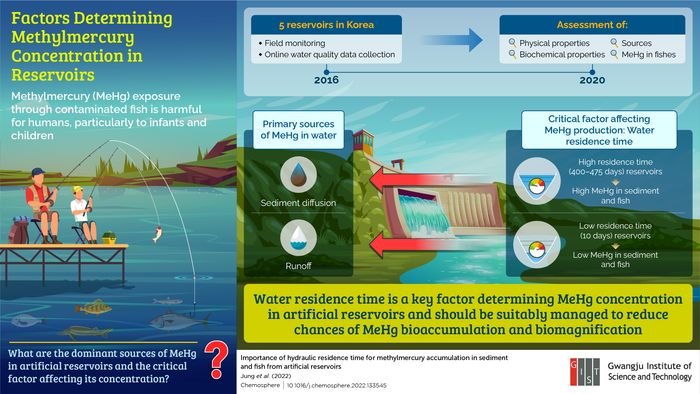During the 1950s and 1960s, Minamata Bay in Japan was the site of widespread mercury poisoning caused by the consumption of fish containing methylmercury—a toxic form of mercury that is synthesized when bacteria react with mercury released in water. Mercury poisoning caused deaths and widespread neurological disorders, as well as intergenerational harm as many of the survivors had children with birth defects. As methylmercury was stored in fish, it continued to remain in the food chain long after the discharge of mercury into the environment has ceased.

Credit: Gwangju Institute of Science and Technology (GIST)
During the 1950s and 1960s, Minamata Bay in Japan was the site of widespread mercury poisoning caused by the consumption of fish containing methylmercury—a toxic form of mercury that is synthesized when bacteria react with mercury released in water. Mercury poisoning caused deaths and widespread neurological disorders, as well as intergenerational harm as many of the survivors had children with birth defects. As methylmercury was stored in fish, it continued to remain in the food chain long after the discharge of mercury into the environment has ceased.
The dangers posed by methylmercury to unborn children have concerned Eunji Jung, a Ph.D. student who works in the Trace Metal Biogeochemistry Laboratory at the Gwangju Institute of Science and Technology (GIST). “As the health of infants and children is an important issue for all women, I felt great responsibility as a female scientist while conducting this research,” explains Jung.
As part of a program to assess the methylmercury levels in aquatic systems in Korea, Jung and her colleagues under the guidance of GIST Professor Seunghee Han monitored mercury levels in five artificial reservoirs between 2016 and 2020. “We analyzed total mercury and methylmercury concentrations in water and sediment, and total mercury concentrations in common fish species. Data from the national water quality monitoring network were used to comprehensively understand the temporal and spatial variations in reservoir conditions; this was necessary to analyze the transport and fate of mercury,” explains Prof. Han.
Their findings were made available online on 5 January 2022 and were subsequently published in Volume 293 of the journal Chemosphere in April 2022.
They found that most of the mercury in the reservoirs originated from soil in the catchment areas. In reservoirs with shorter water residence time, i.e., from which water was frequently discharged, the major source of methylmercury was surface runoff. In reservoirs with longer water residence time, where water was stored longer, the source of the toxin was accumulated methylmercury in the sediment. Methylmercury in sediments was also the source of mercury in fish, and higher mercury concentration were found in fish from reservoirs with longer residence times.
The researchers explain that it is possible to reduce mercury contamination in reservoir fish by preventing accumulation of methylmercury in the reservoir’s sediment. They suggest increasing the rate of water discharge from reservoirs to accomplish this. “Reducing the synthesis rate of methylmercury by controlling the water residence time should ultimately exert a positive effect on human health,” observes Jung.
Continuous monitoring of reservoir water quality might help detect human activity-induced changes in mercury levels and lower methylmercury poisoning due to fish consumption.
***
Reference
DOI: https://doi.org/10.1016/j.chemosphere.2022.133545
Authors: Eunji Jung1, Hyogyeong Kim1, Daseul Yun1, Md Moklesur Rahman1, Jong-Hyeon Lee2, Suhyun Kim2, Chan-Kook Kim3, Seunghee Han1
Affiliations:
1Gwangju Institute of Science and Technology, Republic of Korea
2Environmental Human Research & Consulting (EHR&C), Republic of Korea
3Marine Environment Research Institute, OCEANIC C&T Co., Ltd, Republic of Korea
About the Gwangju Institute of Science and Technology (GIST)
The Gwangju Institute of Science and Technology (GIST) was founded in 1993 by the Korean government as a research-oriented graduate school to help ensure Korea’s continued economic growth and prosperity by developing advanced science and technology with an emphasis on collaboration with the international community. Since that time, GIST has pioneered a highly regarded undergraduate science curriculum in 2010 that has become a model for other science universities in Korea. To learn more about GIST and its exciting opportunities for researchers and students alike, please visit: http://www.gist.ac.kr/.
About the authors
Eunji Jung is a Ph.D. student in the Trace Metal Biogeochemistry Laboratory in School of Earth Sciences and Environmental Engineering at GIST. Her research focus is mercury methylation in lake sediment.
Seunghee Han is a professor and director of the Trace Metal Biogeochemistry Laboratory in School of Earth Sciences and Environmental Engineering at GIST. Her group deals with the topics of biogeochemical behavior of trace metals and toxic inorganic pollutants in aquatic systems. She received an MS from the Department of Chemistry at Yonsei University and a Ph.D. from the Department of Oceanography at Texas A&M University.
Journal
Chemosphere
DOI
10.1016/j.chemosphere.2022.133545
Method of Research
Observational study
Subject of Research
Not applicable
Article Title
Importance of hydraulic residence time for methylmercury accumulation in sediment and fish from artificial reservoirs
Article Publication Date
1-Apr-2022
COI Statement
The authors declare no competing interests.




